
- Plant Biology
- Human Biology
- Biology Plant Biology Water Transport Experiment

How does water move in plants?
Have you ever wondered how plants are able to pull water out of the ground? It’s not like they have a heart to pump water around or even a digestion system to extract the water from the soil!
In fact, water movement in plants doesn’t rely on energetically expensive biological pumps or even magic. It relies on some pretty basic physical principles operating within unique plant structures, and anyone can understand it. We’ll see how in this home experiment.
3 glass or plastic cups (sturdy enough not to tip over) 300 g room-temperature water Food coloring Metric scale Fan Medium-to-large sealable plastic box (tall enough to fit an upright stalk of celery inside) 2 small squares of plastic wrap 2 stalks celery, leaves attached
- Pick two celery stalks that they have similar amounts of leaves. (Hint: If you can’t find celery with leaves attached in your grocery store, buy a head of celery. The small inner stalks usually still contain leaves.) Cut off the bases of the stalks so that they are roughly the same height.
- Place one glass on the scale and tare it: press the “zero” button so that the cup registers as “0 g”. Fill with 150 g of room-temperature water; gently place two drops of food coloring in the water; stir. Be careful not to spill any colored water! Repeat with the second glass.
- Place one celery stalk in each glass, leaf–end at the top.
- Wrap one square of the plastic wrap around the top of each glass and the celery stalk. This is to prevent any colored water evaporating into the air directly from the glass.
- Fill the bottom of the plastic box with roughly one inch of room-temperature water. Place one of the cups with the celery stalk inside the box and seal the lid to create a humid, closed environment.
- Place both the boxed celery and the naked celery in front of a fan, and turn it on the lowest setting. Record the time: _________
- Wait 24 hours.
- Boxed celery:___________________________________________
- Naked celery:___________________________________________
- Place the third glass cup on the scale, and tare it again so that the scale reads “0 g”.
- Boxed celery:____________
- Naked celery:____________
- Celery cross-section:____________________________
How does water move up the stalk?
Although plants don’t have circulatory systems like animals, they do have something quite similar—a network of small tubes called xylem , used for carrying water.
Xylem is composed of long, hollow tubes formed by overlapping cells. As these cells grow, they stretch out and elongate, die, and leave behind hollow cavities that are all interconnected to form one long tube. Plants contain many xylem vessels stretching from the roots to the tips of the leaves, just like a series of drinking straws. When you sliced the celery in half and saw colored dots in the cross-section of the stalk, you were actually looking at the xylem vessels!
Xylem works within some basic physical principles to bring water from the ground up into the rest of the plant. The whole process starts out in the leaves: when the plant is photosynthesizing, it opens tiny holes in the underside of the leaf called stomata . The plant does this so that carbon dioxide can flow in, but it also has a downside: water also diffuses out of the stomata at the same time, drying out the inside of the leaf ever so slightly.
As the plant dries out from the leaves, it brings more water in from the xylem due to some interesting chemical properties. Water is a polar molecule, meaning that it’s slightly “sticky”—it forms temporary hydrogen bonds with itself. This creates cohesion ; small quantities of water will tend to stick together rather than scattering and spreading everywhere (think of dew drops on grass). Water also sticks to the inside of small tubes due to a property called capillary action . These two properties allow the water to travel in one unbroken column through the xylem from the roots to the leaves.
What factors affect how water moves through the plant?
Water moves through plants thanks to a few basic principles, but none of these can work without the first step in the process: water loss from the leaves. This process, called transpiration , happens faster when humidity is low, such as on a hot, windy day. This causes water to evaporate quickly, so the plant needs to suck up more water from the ground (or from the cup) to catch up!
When you put the celery stalk inside the plastic box with water, it increased the humidity in the box, so the celery didn’t lose very much water from the leaves. On the flip side, when you placed the naked celery stalk in front of the fan, it was losing a lot of water! It needed to catch up, so it sucked up more water, and food coloring with it.
When you measured the amount of water left in the glasses at the end of the experiment, you found that the naked celery actually did suck up more water. And, in case you didn’t believe the numbers, you could actually observe that the naked celery had a lot more food coloring within its leaves.
Normally, we can’t see transpiration and water transport happening within plants, but rest assured: as long as it’s above freezing, this process is always happening on a mass scale all over the world!
Related Topics
Choose one of the following categories to see related pages:.
- Experiments ,
Share this Page
Lindsay graduated with a master’s degree in wildlife biology and conservation from the University of Alaska Fairbanks. She also spent her time in Alaska racing sled dogs, and studying caribou and how well they are able to digest nutrients from their foods. Now, she enjoys sampling fine craft beers in Fort Collins, Colorado, knitting, and helping to inspire people to learn more about wildlife, nature, and science in general.
Plant Biology-boo
- Monocots vs Dicots Explained
- Phototropism Experiment
- Plant Diversity
- Plant Growth Hormones
- Plant Memory
- Transport in Plants
- Water Transport Experiment
- Why leaves change color
Science Newsletter:
Full list of our videos.

Teaching Biology?

How to Make Science Films

Read our Wildlife Guide

New From Untamed Science


Demonstrate an experiment to show that water is conducted by xylem.
Xylem: xylem is a complex vascular tissue in plants that helps in the transportation of water and minerals from the root system to other parts of the plant. xylem has four major components- xylem parenchyma, fibres, vessels, and tracheids. experiment to demonstrate water conduction by xylem: requirements of the experiment: a beaker, balsam plant, eosin dye, and a stand. the procedure of the experiment: the balsam plant is placed in the eosin solution (red dye) for some time. the veins of the plants have turned red and the shoot appears to be red. the transverse section of the shoot is cut and xylem tissues were observed. observation: after staining xylem tissues (tracheids and vessels) appeared stained while the rest of the tissues remain unstained. conclusion of the experiment: the above experiment proves that xylem tracheids and vessels are responsible for the transportation of water and minerals as they appear red when the plant is placed in an eosin solution..

suppose we conduct an experiment to demonstrate respiration an a green plant . what special precaution is required to be taken in it??


Plants don’t get the admiration they deserve.
I mean, sure, lots of people enjoy gardening. Some may even have a favorite flower. But when it comes time to learn about plant science, most people tune out. In all my years of teaching, I have yet to witness a student get excited about reaching the portion of our biology course when we learn about plants.
Plants just don’t seem to be very exciting. Well, looks can be deceiving. Plants are much more fascinating than we give them credit for.
Without plants, life as we know it wouldn’t exist.
Plants are able to capture energy from the sun and use it to convert carbon dioxide and water into sugar in a process called photosynthesis. Plants and other organisms capable of performing photosynthesis form the basis of nearly every food chain on the planet.
Plants are able to keep track of the seasons.
Have you ever stopped to consider how a plant knows when to grow and when to go dormant? How plant bulbs know when to emerge in the spring , and what triggers a tree to drop its leaves in the fall ? How plants know the optimal time to produce flowers ? Like humans and animals, plants have circadian rhythms : internal “clocks” that read and respond to environmental cues.
Plants have developed tricky ways to attract pollinators.
Like all living things, plants need a way to pass their genes from one generation to the next. Flowering plants (angiosperms) rely on pollination to reproduce. To solve the problem of attracting pollinators to their flowers, members of the plant kingdom utilize a variety of clever methods .
Plants can communicate, both with other plants and with other organisms.
Recent studies have shown that plants can communicate with each other, even over vast distances. How? If injured or under stress, plants can release chemical messages into the air (in the form of Volatile Organic Compounds , or VOCs), and these messages can be transmitted to other plants up to a mile away.
Plants can also communicate to each other underground through what has become known as the Wood Wide Web . The roots of many plants share a symbiotic relationship with fungi by forming mycorrhizae. In this relationship, plants provide the fungi with food (made through photosynthesis) while the fungi provide the plants with nutrients acquired by decomposing organic matter. Impressively, the vast networks of mycorrhizae can connect plants to each other, akin to the way the World Wide Web connects people who may be far apart. Studies have shown that plants can use the mycorrhizae to transmit chemical signals (warning nearby plants of insect attack, for example) and to distribute resources (sugar or nutrients) from plant to plant.
The more I learn about plants, the more fascinated I become.
Have you ever stopped to wonder how water is transferred from a plant’s roots to the rest of the plant’s tissues? Consider a tree: water needs to travel from beneath the ground to reach leaves and branches that may be hundreds of feet above the soil. How does that happen?
And how does the sugar produced within the leaves during photosynthesis get to other parts of the plant so that it can be broken down for energy needed to fuel cellular processes?
Let’s explore a cool aspect of plant science that is fun to experiment with: the plant vascular system.
The Plant Vascular System
I’m sure you’re familiar with the human cardiovascular* system: the series of vessels responsible for transporting necessary substances to and from all of the cells of the body. You may not have known that plants also use a system of tubes to transport essential components throughout the plant. This is called the plant vascular system.
*This post contains affiliate links

Xylem and Phloem
There are two major types of transport vessels within the plants vascular system: xylem and phloem (pronounced zy-lem and flo-em).
Xylem tubes carry water and minerals obtained from the roots of the plant to the tissues above ground. Phloem tissue transport the sugars produced in the leaves to the tissues in the rest of the plant. How does this transport take place?
Within xylem, water and minerals travels in one direction–against gravity–as it is transported from the roots up and throughout the plant. What drives this process?
Have you ever placed a corner of a paper towel in water, and watched how the water is instantly absorbed and transferred across the expanse of the towel? The water is wicked from the wet part of the towel to the dry parts. This happens because water molecules are naturally “sticky”: the molecules stick to each other, and they stick to other objects.The movement of water through xylem occurs in much the same way. The water in the wet part of the xylem within the roots is wicked up to the dryer parts farther up the plant.
Plants continually lose water through their leaves. In order for photosynthesis to occur, leaves need access to sunlight, water, and carbon dioxide. How do they get the carbon dioxide? The answer may surprise you.

Leaf Stomata
Each leaf has tiny holes called stomata (stoma is the singular form). The word stoma comes from the Greek word for mouth, and perhaps knowing that will help you remember the purpose of leaf stomata. It is through the stomata that leaves “breathe” Leaves don’t actually breathe in the same way we do, but they do perform gas exchange. Through stomata, leaves take in carbon dioxide and release oxygen.
During the day when the sun is shining, the stomata of leaves are kept open to allow gas exchange so that photosynthesis can occur. You can watch the process of stomata opening in this video.
Transpiration
While the stomata are open, water loss occurs from the leaves in a process called transpiration. In fact, transpiration of water from plants back into the air is actually a part of the water cycle!

The water loss from leaves due to transpiration is what drives the movement of water through the xylem through wicking action, as shown in the following video.
Unlike the one-way transport that occurs within xylem, movement of sugars and other compounds through phloem can occur in either direction (up or down). This process, called translocation, delivers sugars from the leaves (the source) to the tissues of the plant that need energy to grow (the sink). Translocation depends on a series of cells within the phloem and requires an expenditure of energy.
Within plants, xylem and phloem tissue exist side by side in what is called vascular bundles. These vascular bundles are organized in different ways depending on the part of the plant. Learn more in the following video.
Hands-On Activities to Study Transpiration and the Plant Vascular System
View transpiration in living leaves.

It’s easy to view transpiration for yourself. All you need to do is take a clear, sealable plastic bag and use it to enclose a single green leaf. Make sure that the entire leaf is inside the bag, and that the bag is sealed around the leaf stem as closely as possible to prevent water loss.
Depending on how hot and sunny the location of your plant is, you should begin seeing water vapor accumulate within the bag in no time.
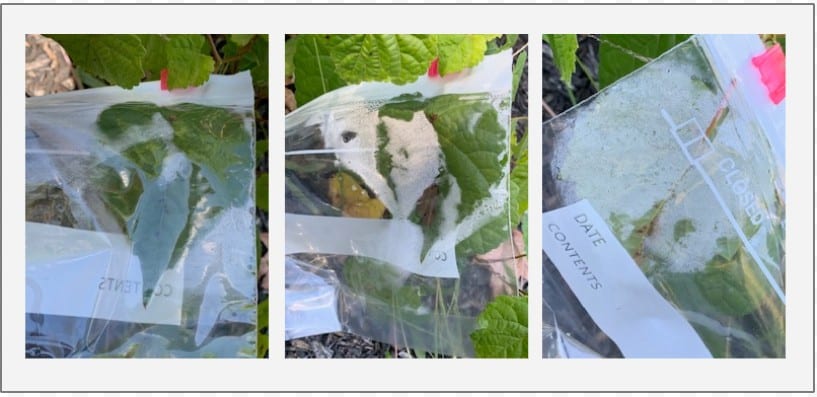
You could take this experiment further and compare how much water transpires from different types of leaves or at different times of day.
View Leaf Stomata Using a Microscope
Speaking of leaves, would you like to view stomata?
All you need is a microscope , blank slides , and items you likely already have at home. While it’s possible to see leaf stomata directly using a microscope, you can create a permanent impression of leaf stomata using a simple procedure.

You can find the instructions for this easy lab here.
Using Celery to View the Vascular System
If you’d like to get a good look at vascular bundles, all you need is some celery stalks (with leaves attached), a glass, water, and food coloring.
Take a stalk of celery and cut off a small slice at the bottom to remove any hardened tissue. Place the celery in a glass containing water (approximately ⅓ cup) and food coloring of your choice. (You’ll want to go heavy on the food coloring if using liquid food coloring. You may not need as much if you’re using food coloring gels).

Within an hour or so, you may notice that the celery leaves have started to change color as the colored water makes its way up the stalk.
After a few hours, remove the celery from the water. Cut a slice off of the bottom of the celery and examine the slice. You should be able to see that as the colored water traveled up through the xylem, it left color behind in the vascular bundles.
If you make a thin cut lengthwise along the celery stalk, you may be able to get another view of the vascular bundles.

Create Your Own Colored Flowers
As long as you have those glasses full of colored water, why not use it to make something pretty?
Most grocery store floral departments sell white (or light-colored) flowers. Buy some, cut a bit off the stems (to remove hardened tissue) and place them in the colored water. The colored water will make its way up the xylem and into the flower petals.

I’ve done this over the years with carnations and chrysanthemums. I’ve seen others have success using white roses as well. You can take this further by cutting the bottom of the stem of a single flower lengthwise and placing each end in a different color of water. This will allow you to create a flower with petals that are two different colors.
I hope I’ve started to convince you that there’s more to plants than meets the eye.
In fact, the reason that leaves change color and fall each autumn is related to the plant vascular system and transpiration.
It is estimated that up to 95% of a plant’s water loss occurs through transpiration from stomata. Recall that stomata open to allow gas exchange to occur so that photosynthesis can happen.
As the days shorten and temperatures drop in the fall in winter, conditions for photosynthesis are no longer conducive. To prevent water loss through leaf stomata, plants seal off the leaves from the rest of plant. Without access to water and minerals from the soil, the leaves stop conducting photosynthesis. Over time, chlorophyll—the bright green pigment that drives photosynthesis—begins to break down, and the other leaf pigments are revealed. Those brilliant yellows and oranges that we associate with fall foliage are actually present in the leaves year-round, but are masked by the bright green chlorophyll.

If you’d like to learn more about the Science of Autumn Leaves , I have created a free, self-paced, online mini course. It contains instructions for a fun, hands-on experiment that uses simple paper chromatography to separate the different pigments in leaves. By comparing the pigments present in green, red, yellow, and orange leaves, students can visualize what happens inside a leaf during the fall color change. You can access the free course here .
Further Information
Water Uptake and Transport in Vascular Plants
Evapotranspiration and the Water Cycle
Process of How Trees Absorb and Evaporate Water via Roots and Leaves
Why Do Leaves Change Color in the Fall?
The Science of Spring
Carnivorous Plants: Why Do They “Eat” Meat?
Colorful Walking Water Science

My online high school biology students learn all about the plant vascular system as we study cellular energy, ecology, and Kingdom Plantae: one of the six biological kingdoms of life. If you’re looking for a fun, engaging class with plenty of opportunities for hands-on exploration, check out the classes I have to offer here: High School Science Classes Taught by Dr. Kristin Moon

*The cardiovascular system is also referred to as the circulatory system
*As an affiliate for Amazon and Home Science Tools, I may earn a commission if you use my affiliate link to make a purchase. This doesn’t affect your price in any way, but helps me with the cost of maintaining my website so that I may continue to share resources to help you understand, teach, and love science.
5 thoughts on “Hands-on Activities to Study the Plant Vascular System”
excellent study. Saving for when my lad reaches the vascular system of plants in his biology course. 🙂
The Real Person!
Author Kristin Moon acts as a real person and passed all tests against spambots. Anti-Spam by CleanTalk.
Thank you! Best of luck to you both. Biology is so much fun!
This is so cool! Our kiddos will be excited to give this a try.
I’m so glad you found it useful! I hope your kids are amazed with their results!
Absolutely! These terms can definitely be confusing!

Leave a Comment Cancel Reply
Your email address will not be published. Required fields are marked *
Save my name, email, and website in this browser for the next time I comment.

Hi, I'm Kristin!
I share tools and resources to help you understand and teach science.
Sign up to receive my newsletter and exclusive freebies.
Thanks for subscribing!
One last step to access your free course!
Create your login now!
Homeschool Science for Kids
Science designed for your homeschool family
Water Movement Through Xylem
September 8, 2016 By Janice VanCleave

Do Plants Suck Up Water?
The cartoon diagram shows a flower using a straw to drink water from an underground stream. I’ve never seen a flower drinking through a straw, but water underground is pulled to the surface of plant leaves and flower petals in much the same way. Instead of a straw, plants have tube-like structures from the roots to the leaves and flower petals. These tubes are called xylem.

Xylem tubes are very small. Water moves up small tubes because the water molecules are attracted to the cellulose chemical in the walls of the plant tubes. This attraction between unlike molecules is called adhesion. Water molecules also have a strong attraction for each other, which is called cohesion. In the diagram, animated diagrams of water molecules are shown. The molecules walking up the walls of the narrow tube are pulling water molecules up the center of the tube. When you look at the surface of water in a thin tube, you will notice that the water moves up the sides and sinks down in the center. This downward dip in the water level is called the meniscus. The movement of the water through tubes or spaces because adhesion and cohesion is called capillary action.
Capillary action moves water up narrow tubes, such as xylem tubes in plants.
Capillary action occurs due to the cohesive force of attraction between water molecules and the adhesive force of attraction between water molecules and the molecules in the walls of the tube.
Due to gravity, capillary action can only raise water a short distance up the xylem tubes in plants. Another process called transpiration pulls the water to the top of the xylem where it moves in to the cells of leaves, stems, flowers, and other organs.
The process of traspiration is similar to the process of drinking through a straw. Both processes raise the height of a liquid in a tube. When you suck the air out of a straw, you decrease air pressure pushing down on the liquid inside the straw.Air pressure outside the straw is still pushing down on the surface of the liquid in the glass. Thus, air pressure is pushing the liquid up the straw to your mouth.
In plants, liquid water moves from the roots to small openings in the surface of leaves and flower petals called stomata. At the surface, liquid water evaporates when a stoma is open. Evaporation of the water creates a low pressure at the top of the xylem tube. The higher pressure on the water at the bottom of the xylem pushes the water up. As long as there is available water for the roots, the xylem remains filled with water.
Nutrients in the soil that dissolve in water are carried from a plant’s roots up xylem tubes to different parts of the plant, such as leaves and flowers.
You now know why and how, but this is all secondary research . While secondary research, done by others, can be accepted as true, encourage kids to investigate in order to “see it for themselves.” In other words, experimentally prove that nutrients dissolved in water move from the roots through a plant’s stem to its leaves. This is called primary research.
Problem: Prove that nutrients dissolved in water move through xylem in a plant’s stem.
tap water measuring cup 2-1 pint glass jars red food color 2 innerstems from a stalk of celery (Pull the outter stems off and use the inner pale celery stems and leaves) lighter colored inner stems.) * knife (adult use only) cutting board magnifying lens camera (optional)
Preparation of Materials by an Adult Pour 1-cup (250 mL) of tap water into each glass jar. • Add 20 drops of food color to the water in one of the glasses. • Place the celery stems on the cutting board and with a knife cut across the bottom of each stem. Cut each stem again, cutting off a small slice.
Tip: Scissors can crush the tiny vessels in the stem, thus affecting the transport of water.
• Without delay, stand 1 celery stem in the colored water and the remaining celery stem in the glass of uncolored water.

Procedure 1. After placing the celery stems in the two glasses, kids should observe and record the appearance of the surface of the celery slices. Look for the xylem tubes around the outside edge of each slice. The diagram shows the location of these tubes.
Recording observations: Colored drawings with word descriptions. In addition to student descriptions, use a camera to take a picture of the two celery slices.
2. Observe and record the color of the leaves on each celery stalk. As before, make a colored drawing.
Hypothesis-1: Ask kids to predict what they think the leaves on the celergy stalks will look like in three days. They are to record their hypothesis by drawing colored pictures.
3. After 24 hours, observe and record the appearance of the leaves. Lift each stalk and observe and record the bottom cut surface. Note: Having kids to make colored drawings is not busy work. Instead, the time it takes to draw and color their observations helps to keep their mind focused on the topic being studied. As they make their drawings on the first day, 24 hours after the experiment started, ask them to give ideas about how the color moved from the colored water in the glass to the leaves? Older kids can do research to discover on their own how the coloring is transferred. Provide clues by giving them this list of terms: capillary action, transpiration, xylem
4. Conclusion: Describe the results. State your hypothesis and whether the experimental results did or didnot support your hypothesis.
Science Fair Project Ideas
Follow the previous procedure using white long stemmed carnations instead of celery stalks. Hold the flower stems under water and cut at an angle. Measure the time it takes for the color to reach the end of the flower petals. This will be the rate of petal coloration or the flow rate of water through xylem.
The results of the experiment will provide data used as a control for a science project. Your science project experiment will have only one of the variables in the experiment changed. Examples of variables that can be changed are:
- Length of stem
- Using a different white flower, such as a white daisy.
- Use different concentrations of the food coloring–higher and lower.
- Multicolored flower–block part of the stem with Vaseline to determine is only part of the flower can be colored.
- Use distilled water instead of tap water
- Method of cutting the stems–Angle of cut, cutting underwater, cutting in the air.
Examples of a Science Project Experiment Question 1. What affect does the length of the stem have on the rate of petal coloration? 2. What affect would different types of flowers have on the rate of petal coloration?
Share this:

Related posts:
- Developing A Science Fair Project
- More About Surface Tension
- What is Surface Tension?
- How Salt Melts Ice
- Flower Parts for Reproduction
- Water Critters
- Borax Crystals
- Electrically Charged Bees
- Why Boats Float
- How Butter Is Made: At Home
- Skip to primary navigation
- Skip to main content
- Skip to primary sidebar

- FREE Experiments
- Kitchen Science
- Climate Change
- Egg Experiments
- Fairy Tale Science
- Edible Science
- Human Health
- Inspirational Women
- Forces and Motion
- Science Fair Projects
- STEM Challenges
- Science Sparks Books
- Contact Science Sparks
- Science Resources for Home and School
Transport in Plants – Capillary Action
March 31, 2016 By Emma Vanstone 2 Comments
Have you ever wondered how water is transported up the stem of a plant against gravity? This transportation process is called transpiration. We can demonstrate transpiration with these easy transpiration experiments .
You might also like our plant respiration and photosynthesis investigations .
Transport in Plants – Transpiration
Transpiration occurs when water on the surface leaf cells evaporates and then diffuses out of the leaf. This draws water out of the xylem cells inside the leaf to replace the evaporated water. Xylem cells form a continuous tube from the leaf to roots which acts like a drinking straw giving a flow of water from root to leaf.
Transpiration helps another process called capillary action to take place, which is how water moves through a plant.
Water molecules are attracted to the molecules of the inside of the stem. It is this attraction which helps force the water up from the ground and around the plant.
Transpiration Experiment
You can demonstrate capillary action and transpiration by placing a flower in a glass of coloured water. After a few hours the petals will turn the same colour as the water, this is because the coloured water is transported up the stem and into the petals.
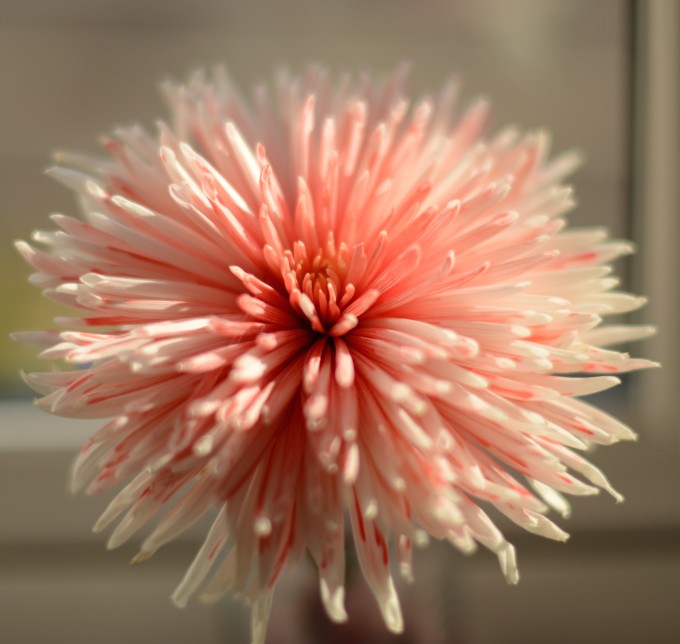
Transpiration Definition
Transpiration is the movement of water through a plant and evaporation from leaves, stems and flowers.
Water moves through the xylem vessels of a plant in a continuous transpiration stream .
root – stem – leaf
Functions of Transpiration – transport in plants
Transport of mineral ions
Transport of water to all parts of the plant, including leaf cells where it is needed for photosynthesis.
Keeping leaves cool as water evaporates from the surface.
What factors affect transpiration?
There are three forces involved in this process of transporting water in plants.
Adhesion allows water to stick to the organic tissues of a plant.
Cohesion keeps the water molecules together.
Surface tension holding the water molecules together as they are transported through the plant.
Capillary Action Definition
Capillary action s the movement of a liquid through a narrow space as a result of cohesion, surface tension and adhesion.
For capillary action to work, the adhesion force between the water and plant tissues must be stronger than the cohesion between water molecules.
When a water molecule is more attracted to the plant, it is pulled towards the plant tissue, but as water molecules are highly attracted to each other the first molecule brings further water molecules with it.
Plants use two different transport systems, both of which are rows of cells which form tubes around the plant.. The xylem transports water and minerals from the roots to the leaves while the phloem moves food substances from leaves to the rest of the plant.
Plant Stem Model
We used straws to make a very simplified model of a plant stem. The xylem is the centre yellow part and phloem the blue straws.
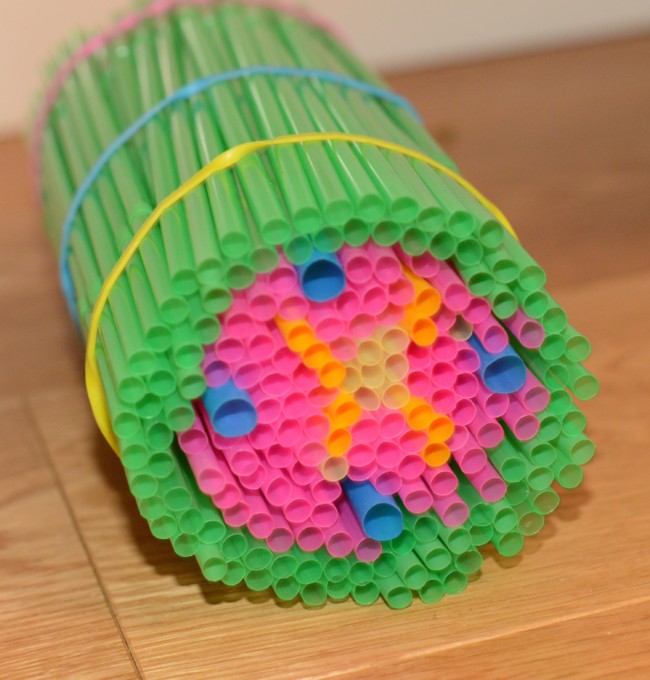
Easy capillary action experiment
This simple experiment is a super easy and fun demonstration of capillary action and water transport in plants .
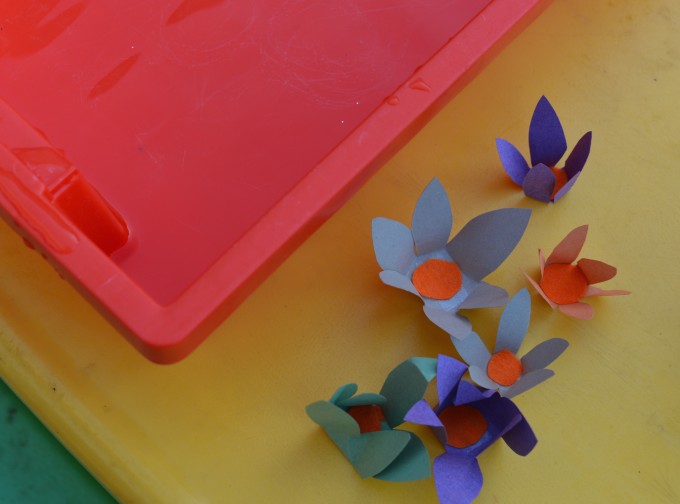
Paper – sugar paper works best
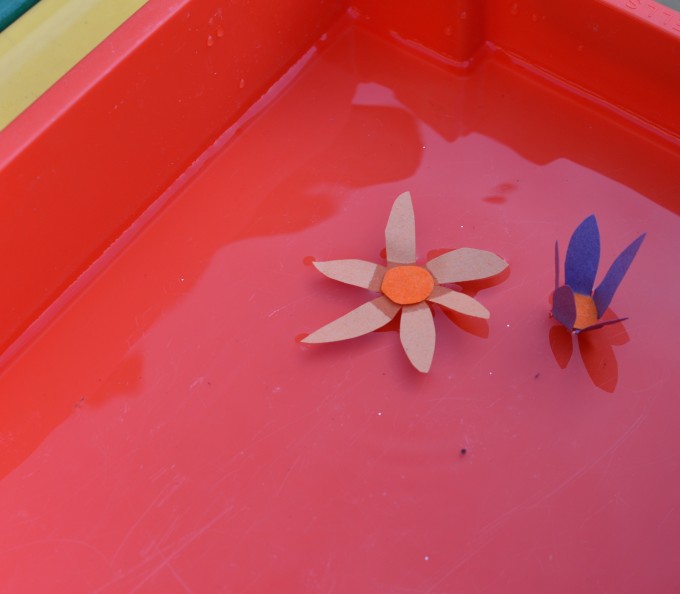
Cut out several flower shapes from the sugar paper.
Curl up the edges and place on the surface of the water.
Watch as the flower opens up.
How does capillary action work?
Paper is made of lots of fibres, as they absorb the water they swell and the paper expands, which made the flower shapes open up.
This process is called ‘capillary action’, the water uses this process to move along the tiny gaps in the fibres of the paper. It occurs due to the adhesive force between the water and the paper being stronger than the cohesive forces inside the water itself. This is the same process by which water travels from the root up the stem and to the petals of a plant.
More transpiration experiment ideas
The DK Website has some great plant facts for kids .
We also used two syringes to show water travelling up the stem of a LEGO plant, which is quite a nice model for younger children.
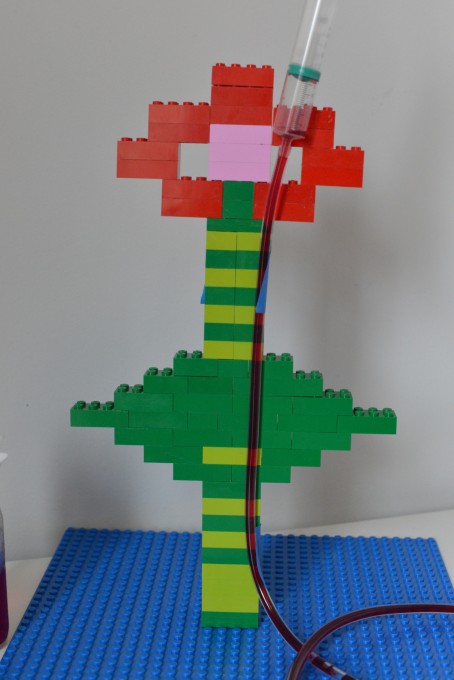
Suitable for Key Stage 2 Science
Plant science.
Investigate the way in which water is transported within plants
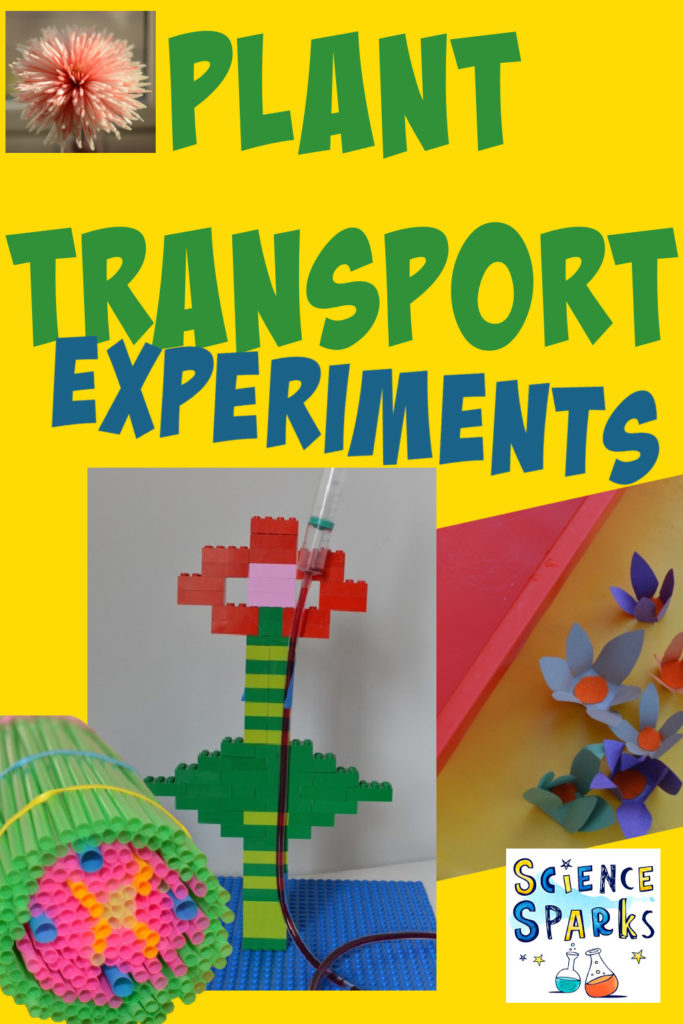
Last Updated on July 16, 2022 by Emma Vanstone
Safety Notice
Science Sparks ( Wild Sparks Enterprises Ltd ) are not liable for the actions of activity of any person who uses the information in this resource or in any of the suggested further resources. Science Sparks assume no liability with regard to injuries or damage to property that may occur as a result of using the information and carrying out the practical activities contained in this resource or in any of the suggested further resources.
These activities are designed to be carried out by children working with a parent, guardian or other appropriate adult. The adult involved is fully responsible for ensuring that the activities are carried out safely.
Reader Interactions
April 06, 2016 at 9:05 pm
I love the addition of using paper flower shapes to show capillary action- much more exciting than the traditional paper towel in a cup! Great idea with the LEGO model too. Thanks for sharing!
December 09, 2022 at 11:14 pm
I can’t wait to do this with my preschool class in the Spring!
Leave a Reply Cancel reply
Your email address will not be published. Required fields are marked *

Farmer Scientist: Xylem Leaf Dye Experiment
Updated: Apr 6, 2021
Have you ever wondered how water travels through leaves? What happens when you water a plant? Water is essential for the survival of plants, and plants need a way to "drink" the water in order to stay strong and healthy! In this experiment, we used food coloring, water, and leaves to see how water moves through leaves.
You can watch the video below, click through the Google Slides link for a fun and educational presentation that is great for students at home or in class, view photos from our experiment, and then follow the instructions to try the experiment yourself!
Watch the video
Google Slides Presentation
Check out our Google Slides presentation ! Feel free to share with your students at home or in class.
View photos from the experiment.

Get Inspired!
If you do the experiment at home, we'd love for you to share it with us on social media: tag @grownyc and use the hashtag #GrowNYCEducation
Xylem Leaf Color Experiment: Instructions
Objective: To investigate how water travels through leaves using food coloring and leaves and to learn about the importance of the xylem in the process of water and nutrient transportation in plants.
Material(s) needed:
Leaves: you can use leaves of all different shapes and sizes! The experiment works best if the leaves have visible veins and are a lighter shade of green/orange, or have a white center.
Red food coloring
Get outside and collect a few leaves! Make sure the leaves have stems.
Fill your cups with water about halfway.
Add a few drops of food coloring to the water. The darker the water, the clearer the results!
Place your leaves into the cups, taping them to the sides if the stems are too short. Just make sure some of the stem is in the water.
Observe the leaves over the next few days. Take photos or draw pictures of your leaves every day to record the changes.
Conclusion:
After several days, you should be able to see that the red dye has travelled up the plant - what you're seeing is the plant's xylem in action!
The xylem is the tissue in plants that carries water and minerals from the root to the rest of the plant. Xylem is found in the roots and in the leaves. It’s like a circulatory system for plants!
Stay tuned for our next experiment!

Post author: Nicole Engen
Recent Posts
Farmer Scientist: Leaf Color Experiment
Farmer Scientist: Irrigation Challenge Experiment
Farmer Scientist: Photosynthesis and Respiration Experiment
Comentários

A hands-on approach to xylem and phloem
If you teach science, or interact with students who have taken an elementary or middle school science course, there is a good chance they have taken part in a lab that demonstrates how colored water can change the color of a plant. Sometimes this lab is carried out with white carnations (a little pricey, but my preferred method) and sometimes with celery, but the end result is always the same. Students observe the seemingly magical conversion of a plant’s color simply by adding food coloring to its water source. It’s a pretty common lab and, admittedly, one of my favorites.
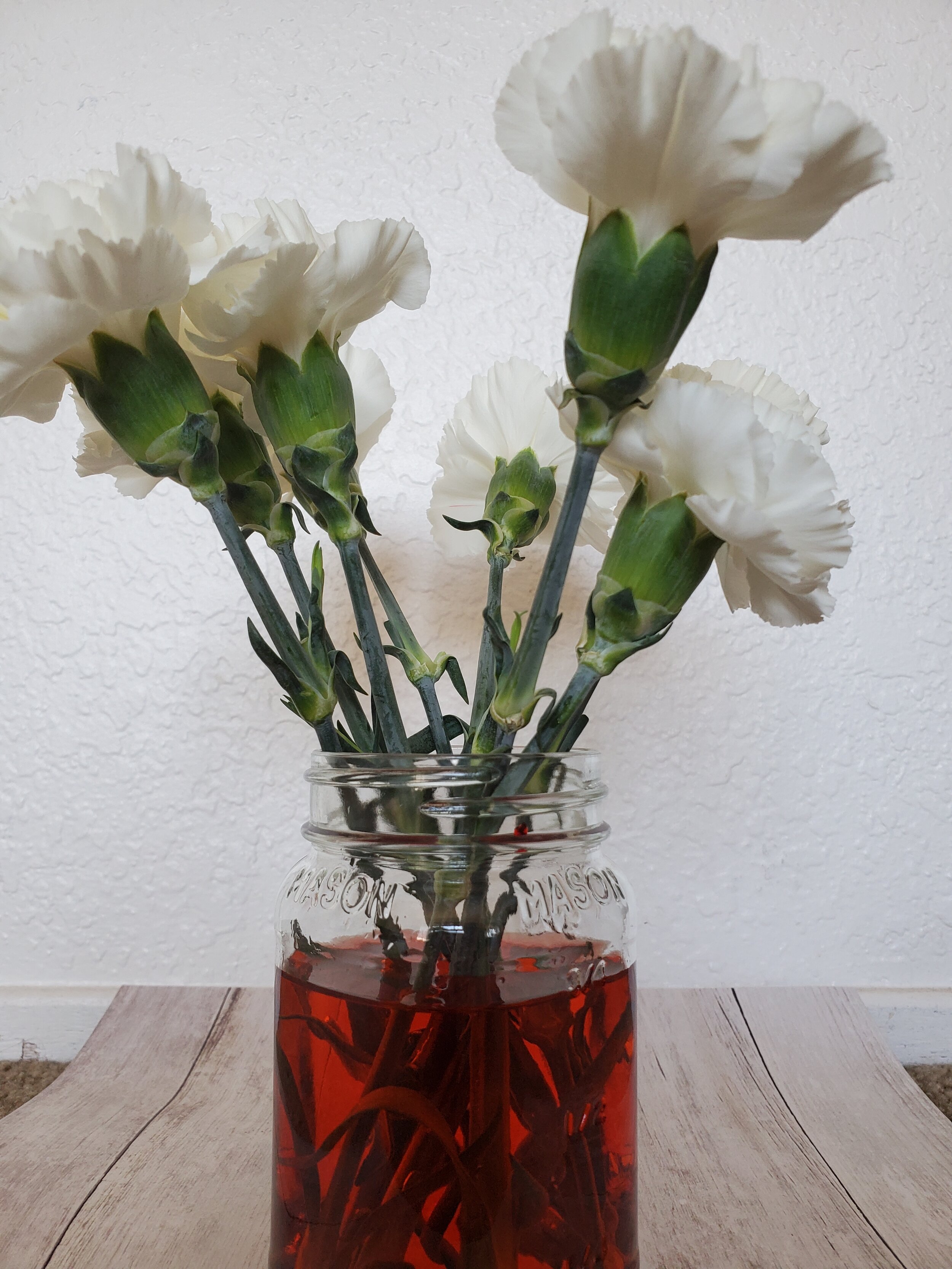
I love seeing this lab utilized with younger students. It’s such a simple, highly observable phenomenon that young kids especially (but even middle schoolers- though they will try to act very nonchalant about it) find exciting. And after all, isn’t that one of the main objectives of science education k-8? To expose students to everyday phenomenon that gets them excited, asking questions, and wanting to find out more?
I have utilized the Color-Changing Carnations lab for many years in my career as a science educator. Many times, I had students in my classes that would announce, either with pride or with boredom, that they had in-fact completed this lab before. They knew what would happen. But that was okay because, as 7th graders, we would be moving the lab forward, not stopping at the simple observation of the color change but dissecting the plant after, exploring the interior of the stem and even viewing it under the microscope. We would bring all the reading, lecture notes, and information about the xylem and phloem to life by extending the lab beyond simple observation.
For many years, I did just this. I followed this pattern in teaching. I lectured, we read, we viewed lovely detailed, artistic renditions of the xylem and phloem and then, finally, we would view the phenomenon and complete our dissections. These weren’t bad lessons. Any time we give students an opportunity to engage in the science and go beyond the reading and artistic renditions, any time we let them formulate an understanding of the concepts on their own, that is a win for science education. But, somewhere along the way, it occurred to me that I had taken the wonder and mystery out of the phenomenon before ever giving the students an opportunity to ponder it.
I’ve written about this before here , but I think it’s worth noting again. Flipping the science experience, particularly in k-8 classrooms, is a valuable educational experience. It builds a hands-on, concrete, shared experience for all students so that all students can participate in and contribute to a shared discussion. Let’s be honest, some (if not most) of our students get lost in the language of science, bogged down by the complex vocabulary that is inherent to science text, unless they have a concrete experience to fall back on when they are doing the reading. Here is how I create this experience for a plant vascular lesson in my Life Science classes:
Create the Experience First…
Without much detail or information, I have students set up the phenomenon. Students are given white carnations, glasses filled with water, and their choice of food colorings with which to color the water. I always try to give each student their own flower and I have found that if I talk with the florist at my local grocery store, they are often willing to give me a discount on the flowers (sometimes I even score them for free!). Depending on the space I have available in my classroom, I will let each student have their own cup and choose their own color individually, but sometimes they need to share cups (either as pairs or as table groups) and agree on a color. I limit the colors to those that are going to show up best in the interior of the stem, usually red and blue though I will let students mix the two colors to create purple.
Engage in Discussion…
Perhaps the most important part of flipping the science experience is the student-led discussion. It is so important to ultimately let the students drive the discussion, ask questions, and make predictions about what is driving the phenomenon.
To begin this process, I have students take time to reflect and write down their predictions and their questions before starting the discussion. This gives all students some “think time.” I then engage students in a conversation about their predictions of what might happen (a hypothesis). As I mentioned before, some students will have completed this lab previously so they will already “know,” and that’s ok. It’s important to have student experts in the classroom during these experiences. If needed, I will drive the conversation further by asking leading questions, but I also open up the floor for students to ask their own questions. Some possible leading questions are:
Why will the petals change?
Will the entire flower change color or just parts of it?
Will the stem change color? Why or why not?
What about the interior of the stem?
If the carnation does somehow change color, how does that work? Aren’t things suppose to move down, not up?
Often I will record student predictions and questions on a chart throughout the discussion. It takes time and practice for this process but the end goal as the teacher is to say as little as possible and let the students to most of the talking. I take down any ideas they have, no matter how possible or improbable. I aim to encourage their critical (and creative) thinking skills, as well as their collaborative discussion. It’s probably the hardest part about the lab, to say nothing more than “that’s an interesting thought” and “I can’t wait to see what we find out next.” It’s also hard on the students at first as so many of them have grown accustomed to being told the answer rather than discovering it on their own.
Find Out What Happened…
Within a day or two, the white carnations will have changed to the hue of the water they are sitting in. While many students will be delighted by this, not as many will be surprised. What is often surprising is what they find when they cut the stems open. Here is where students really get to work “being a scientist.” They are encouraged to dissect the flowers and examine the interior of the stems. If microscopes or magnifying glasses are available, they are encouraged to take a closer look at the interior. What do they notice? Is anything surprising? As they examine their flower in great detail, they are asked to record (in detail) what they see and, just like actual scientists, discuss collaboratively with their fellow students about what they have found. Some students will notice and be able to point out what other students have not seen.
I really feel like this “informal discussion” is another important part of the flipped science experience. Students should be encouraged to turn to each other as they discover, question, and hypothesis about what has happened to their flower. In this way, students are truly formulating their own understanding of the experience.
A Final Discussion…
After the dissection, examination, and informal discussion, I bring students back together for one final formal discussion. It’s clear now that the color moved along the stem, but only in parts of the stem. What does that tell us about what might be happening? What do we now know and what do we still need to know? Again, as much as possible, I let students lead the discussion with their thoughts, predictions, and questions, all the while recording as we go.
And Now the Reading…
Now that all the students have a shared experience with the phenomenon, this is when I introduce the reading. All along, students have likely been explaining the science of what is happening using their own language and level of vocabulary and this is absolutely okay. They have created an understanding of the science in their terms. But now, we can relate their understanding to the academic language of science. We can introduce terms like “xylem” and “phloem” and now these complex science words have a true, concrete meaning because the students saw them for themselves. Remember that part of the stem that had color running through it? That was the xylem.
Science is both exciting and rigorous. I believe that the best way we can maintain the excitement of science while also elevating its rigor for all students is by flipping the science experience. Offering the phenomenon first, allowing students to experience the science and become scientists themselves, then linking the academic knowledge to their personal experiences and know-how.
Check out the Plant Vascular System Lesson here , complete with lab details, student worksheets, reading passage and more!

IMAGES
COMMENTS
Xylem is composed of long, hollow tubes formed by overlapping cells. As these cells grow, they stretch out and elongate, die, and leave behind hollow cavities that are all interconnected to form one long tube. Plants contain many xylem vessels stretching from the roots to the tips of the leaves, just like a series of drinking straws.
Xylem: Xylem is a complex vascular tissue in plants that helps in the transportation of water and minerals from the root system to other parts of the plant. Xylem has four major components- xylem parenchyma, fibres, vessels, and tracheids. Experiment to demonstrate water conduction by xylem: Requirements of the experiment:
The vascular system of plants is made up of xylem and phloem Xylem and Phloem . There are two major types of transport vessels within the plants vascular system: xylem and phloem (pronounced zy-lem and flo-em). Xylem tubes carry water and minerals obtained from the roots of the plant to the tissues above ground.
Water Movement through Xylem vessels in Celery INSTRUCTIONS: Conduct an experiment in which you observe the location of the xylem tissue within the stalk of celery, thus showing the movement of water through xylem. MATERIALS: Celery stick – 3 inch piece 2 x plastic cups Razor blade – SHARP! Handle with care - Food Dye Hand lens/Microscope
Sep 8, 2016 · Measure the time it takes for the color to reach the end of the flower petals. This will be the rate of petal coloration or the flow rate of water through xylem. The results of the experiment will provide data used as a control for a science project. Your science project experiment will have only one of the variables in the experiment changed.
When plants are full of water, like the celery in our experiment, some of the extra water leaves the plant through little holes in the leaves called stomata. As water particles move into the air, they pull on the water particles left in xylem in the leaf, which pull on the particles in xylem in the stem, which pull on the
Mar 31, 2016 · The xylem transports water and minerals from the roots to the leaves while the phloem moves food substances from leaves to the rest of the plant. Plant Stem Model. We used straws to make a very simplified model of a plant stem. The xylem is the centre yellow part and phloem the blue straws.
Apr 5, 2023 · Botany Experiment. Learn about amazing plants for kids iwith this intersting and fun botany lesson for kids!From fascinating facts about plants for kids, plant worksheets, hands-on plant activities, creative plant experiments, and even tests with answer keys to test what your child has learned, you will love this fun printable science lesson for kids!
Dec 3, 2020 · Xylem Leaf Color Experiment: Instructions Objective: To investigate how water travels through leaves using food coloring and leaves and to learn about the importance of the xylem in the process of water and nutrient transportation in plants.
Jun 14, 2021 · A hands-on approach to xylem and phloem June 14, 2021 by admin If you teach science, or interact with students who have taken an elementary or middle school science course, there is a good chance they have taken part in a lab that demonstrates how colored water can change the color of a plant.